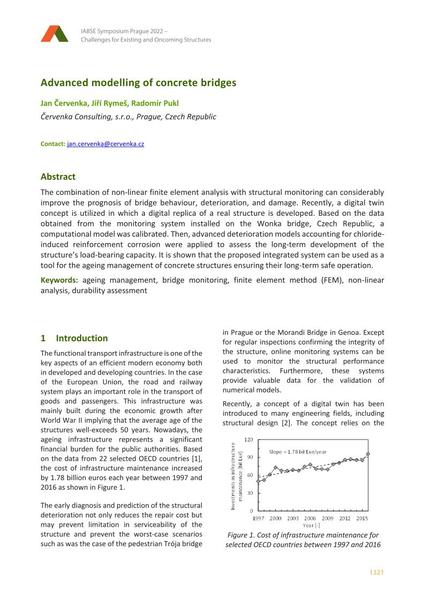Advanced modelling of concrete bridges

|
|
|||||||||||
Détails bibliographiques
| Auteur(s): |
Jan Červenka
(Červenka Consulting, s.r.o., Prague, Czech Republic)
Jiří Rymeš (Červenka Consulting, s.r.o., Prague, Czech Republic) Radomír Pukl (Červenka Consulting, s.r.o., Prague, Czech Republic) |
||||
|---|---|---|---|---|---|
| Médium: | papier de conférence | ||||
| Langue(s): | anglais | ||||
| Conférence: | IABSE Symposium: Challenges for Existing and Oncoming Structures, Prague, Czech Republic, 25-27 May 2022 | ||||
| Publié dans: | IABSE Symposium Prague 2022 | ||||
|
|||||
| Page(s): | 1321-1328 | ||||
| Nombre total de pages (du PDF): | 8 | ||||
| DOI: | 10.2749/prague.2022.1321 | ||||
| Abstrait: |
The combination of non-linear finite element analysis with structural monitoring can considerably improve the prognosis of bridge behaviour, deterioration, and damage. Recently, a digital twin concept is utilized in which a digital replica of a real structure is developed. Based on the data obtained from the monitoring system installed on the Wonka bridge, Czech Republic, a computational model was calibrated. Then, advanced deterioration models accounting for chloride- induced reinforcement corrosion were applied to assess the long-term development of the structure’s load-bearing capacity. It is shown that the proposed integrated system can be used as a tool for the ageing management of concrete structures ensuring their long-term safe operation. |
||||
| Copyright: | © 2022 International Association for Bridge and Structural Engineering (IABSE) | ||||
| License: | Cette oeuvre ne peut être utilisée sans la permission de l'auteur ou détenteur des droits. |
||||
